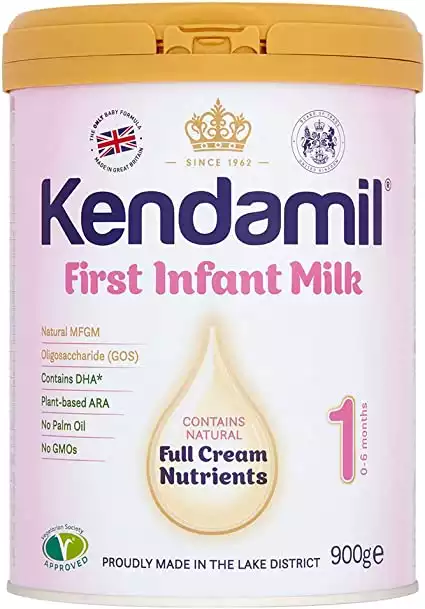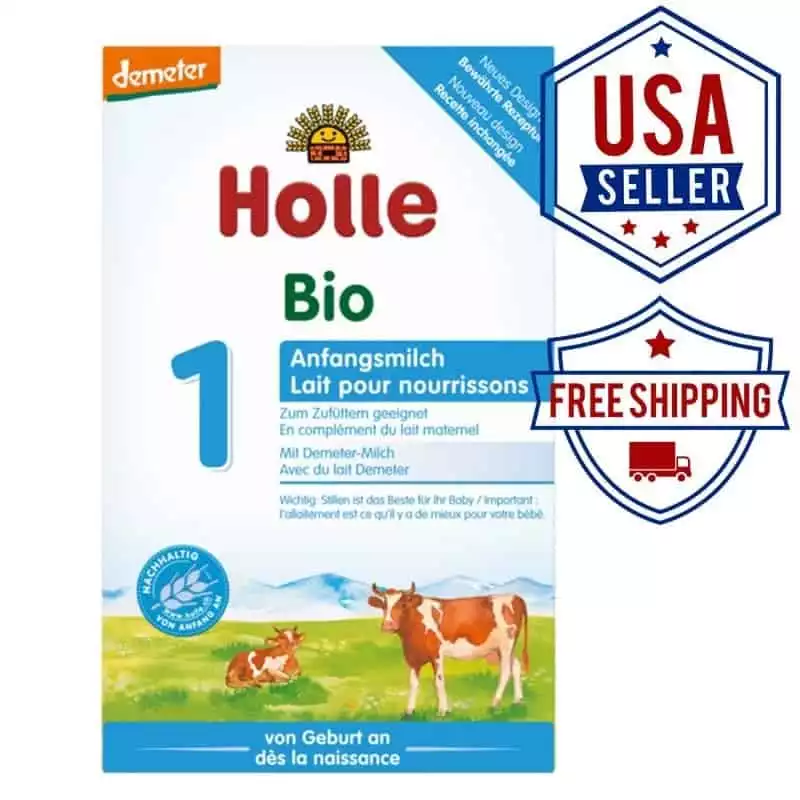- How to choose baby formula - September 4, 2023
- Best amino acid-based formulas 2024 - September 4, 2023
- Best hypoallergenic formulas 2024 - August 30, 2023
“Breast is best, so give babies 6 months minimum of exclusive breastfeeding.” says UNICEF and WHO.” Sounds simple and pretty straightforward, right? Not really, for some mothers breastfeeding is hard, not in the sense that they don’t feel like doing it, but hard as in, they have low milk supply, have undergone a mastectomy, have sore nipples or have mastitis.
So today, we’re comparing two popular products that help with this issue: Kendamil vs Similac baby formula, to see which solution is best.
So if you love breastfeeding, (read our guide on how to increase your milk supply) then that’s great. But if you can’t for one or more reasons, we understand both your decision and predicament. That is why we dedicate this comparison between Kendamil vs Similac to you.
So wear that smile, say to hell with that guilt for if you want to switch fully (just like the other over 19.2% of mothers in the US as shown by CDC report card), supplement or exclusively nurse your baby on formulas, we’ve got you.
We will detail everything from ingredients to pros, cons to real reviews, potential alternatives as well as frequently asked questions before signing off with an objective final verdict.
Simply put, at the end you will have all you need to know whether either of these baby formula brands are for you (or skip to our guide on how to find the best baby formula).
We’ll start off with the main differences. Read on.
This is the only formula produced in the UK, and used by the royal family, your baby will feel like royalty when they taste Kendamil.
Jump to a specific section
Main Differences between Kendamil vs Similac
The main differences between Kendamil vs Similar are:
- Kendamil relies on the naturally sweet taste of whole milk, whereas Similac adds sugar to the formula to make it tastier.
- Kendamil relies only on Prebiotics Via GOS (also found in Similac), whereas Similac uses milk protein isolate as an easy to digest ingredient.
- Kendamil doesn’t contain corn syrup or modified rice starch for ingredients, whereas Similac contains Corn syrup and modified rice starch as the main ingredients.
- Kendamil does not contain maltodextrin in any of its formulas, whereas Similac contains corn maltodextrin (a cheaper and harmful form of lactose).
- Kendamil contains a galacto-oligosaccharide, whereas Similac contains 2′ -FL Human Milk Oligosaccharide or HMO (breast milk prebiotic that boosts the immune).
- Kendamil avoids Palm oils across all its baby products, whereas Similac contains palm oiled oils (breast milk like fatty acid that can be tough on tiny tummies).
- Kendamil formulas are free of Soy, whereas Similac offers soy-based formulas for babies incapable of digesting cow-based milk proteins.
- Kendamil has palmitic acid that helps with calcium absorption in infants, whereas Similac has palm oil that reduces calcium absorption in infants.
- Kendamil uses whole milk formulation as a base (rich in MFGM and fat-soluble vitamins and Minerals – enhances growth and cognitive development), whereas Similac opts for skimmed milk (non-fat milk) that lacks in MFGM (More on this later). See Milk Types Explained.
Kendamil vs Similac Baby Formula Compared
With both brands –Kendamil vs Similac – being compliant with the stringent EU regulations, featuring almost mirror ingredients and being products from reputable brands, pitting them against each other can wear out even the most patient of souls.
That is why, our ever dedicated team took it upon themselves to weigh the pros against the cons, reviews and main ingredients to get you an honest, balanced and informative article (as they always do here and here) about these two great baby formulas. And first on our list is Kendamil;
Kendamil in depth

Sourcing its ingredients from local farms from Yorkshire, Kent and Somerset, and the Red Tractor accredited farms in Cumbria and Lancashire, with the most extensive of certifications that meet EU standards, Kendamil is and has been a serious contender in the production of quality baby products since 1962.
Their commitment to the production of quality products that meet the highest food safety standards saw them launch an organic baby formula in 2018, feeding Prince Louis of Cambridge before being awarded the Royal Queen’s Award in 2020.
Kendamil has a 3 tier stage formulation (read more here) that may have variations in ingredients. The ingredients below therefore may vary from stage to stage. Without further ado, let us dive straight into the ingredients of Kendamil;
Carbohydrates
The main source of energy and essential growth nutrients for our bodies is carbohydrates. But not all carbohydrates are equal for some have more or less of either nutrients or energy. One such carbohydrate is lactose that is common in baby formulas.
Its preference is major because of its ease of indigestion and lengthened time it takes to be digested. Unlike other formulas that skimp on this key ingredient for cheaper unhealthier fillers, Kendamil goes only for the best by sourcing it from grass-fed cow’s milk that is reared in accordance with stringent rearing practices in Britain and EU at large.
Protein
Enough can never be said of the importance of protein in baby formulas. For after all, milk is but a protein. And to ensure that this nutritious component is present in the form, quantity and quality required by your baby, Kendamil uses lactose from cow’s milk with naturally occurring probiotics and prebiotics (more on this later) that make it digestible by your baby’s delicate digestive system.
Fats
Fats are one of the few classes of foods, present in even breast milk, that will make your baby grow strong. For this reason, all baby formulas come loaded with fats.
But unlike most low-end baby formulas that will come loaded with saturated and Trans fats, most of which are linked to Diabetes, overweight, and heart conditions, Kendimil is an exception.
It instead goes for organic vegetable oils and fats with low saturated fat to ensure your baby grows stronger and healthier and that its brain develops at normal rates.
Prebiotics and Probiotics
These two support both digestion and the growth of healthy bacteria in the digestive system. And Kendamil knows this too well and that is why it adds just the approved quantities of Prebiotic GOS by use of cow’s milk.
Unfortunately, in accordance with EU organic regulations – despite its highlighted benefits – Kendamil does not include probiotics in its formulas as it is not allowed. Nonetheless, the correct amounts of Prebiotic GOS added to Kendamil guarantee proper digestion during the infancy stages of your baby.
DHA and ARA
DHA and ARA are long-chain polyunsaturated fatty acids that are naturally found in breast milk and some foods that include eggs and fish. These two fatty acids improve the nerve and immune function, plus support brain development, muscle, and eye growth.
To maintain the high standards it adheres to, instead of using a hexane extraction process that leaves solvent residuals in the formula, it goes for decantation which is purely a natural process that does not require solvents.
Grass-Fed Milk

The Organic milk that is used is free of antibiotics, additives, GMOs, steroids, hormones, and antibiotics.
Whole milk formulation
To improve and support an infant’s growth and development, Kendamil uses whole milk that comes pre-packed with naturally occurring fat-soluble minerals and vitamins. Additionally, it has a Milk Fat Globule membrane(MFGM) which enhances an infant’s cognitive development. This cannot be said of skimmed milk-based formulas that are lacking in these two important ingredients.
Kendamil’s Main Ingredients
- Organic whole milk
- Organic demineralized milk whey protein (whey protein demystified) powder
- Organic skimmed milk
- Organic vegetable oils
- Calcium citrate
- Sodium citrate
- Organic galacto-oligosaccharide
- Folic acid
- Calcium lactate
- Vitamin A, B, B6, B12, C, D, E, &K
- Riboflavin
- Inostol
- Magnesium chloride
- L-carnitine
- Iron Pyrophosphate
- Zinc Thiamine
- Biotin
- Stage one comes packed with Inositol & Choline
- Omega 6 and 3
- Palmitic acid
Disclaimer: The nutritional ingredients may change from time to time and therefore, be sure to check the information contained in the packages.
Pros
- Full compliance with USDA & FDA guidelines.
- Prebiotics for better digestion
- Lacks both corn and sucrose syrups
- No artificial additives
- Free of Gluten and Soy
- No palm Oil
- No constipation, indigestion, or gas
- DHA and ARA are decanted as opposed to hexane extraction
- All stages lack Maltodextrin (a cheaper option compared with lactose)
Cons
- Lacks probiotics
- Ingredients with milk or from milk may be allergic to sensitive babies.
Kendamil Reviews
A number of happy customers were quite impressed with Kendamil products, noting that they left their babies with amazingly soft skins, relieved them of colic, improved their reflux, and always had the baby’s tummy full for longer. They were quick to add that the products also smell great and taste miles better than most of its competitors.
A few others felt that they got the short end of the stick noting that the products left their babies with skin rashes and runny tummies.
Similac in depth

With close to a century of being in the business of feeding babies, a commitment to nourishing your babies with nothing but the best of formulas, an enticement of discounts, and the allure of free samples on sign up, added sugar for the curious taste buds and palettes of your babies, hydrolyzed milk proteins for sensitive tiny tummies, Similac does surely stand out from the competition.
Their years of experience are a testimony to the name they have made for themselves. They boast of being certified and fully compliant with existing FDA rules among other regulations.
Even more impressive is their consistency of research in an effort to produce formulas that are as close as possible to breast milk. Below is a quick rundown of the main ingredients in their formulas;
Carbohydrate
Except in formulas specifically made for lactose intolerant babies, Similac uses lactose as the main carb source. It also includes maltodextrin, corn syrup, and sugars in some (these are other carb sources that are cheaper alternatives and that can substitute or supplement lactose)
Lactose is naturally broken by the baby’s digestive system and often takes longer to be broken down, releasing minute, manageable doses of glucose for the baby.
Fats
To better mimic breastmilk that has some natural fatty acids, Similac uses vegetable oils such as Palm oil, Soy Oil and coconut oil to create a base for the formulas. It is worth noting that this base varies greatly across its range of products.
The one downside to palm oil, (other than the obvious deforestation and reduction of indigenous trees), is that it may bring about constipation and reduced calcium absorption in infants.
Protein
While some of its product line do feature whole milk as the source of naturally occurring proteins, some others come packed with soy oil and soy lecithin.
Milk formulation

Similac uses skimmed milk or nonfat milk that has lower amounts of fat-soluble vitamins. To make up for this deficiency, it later adds some of these vitamins to mimic whole milk components.
Prebiotics and Probiotics
As is EU regulations, Similac – just like Kendamil, only includes prebiotics beneficial to gut bacteria.
DHA and ARA
Some hypersensitive Similac formulas contain DHA and ARA. Such formulas include Similac’s Alimentum that is pre-packed with hydrolyzed proteins (predigested milk proteins) that are easier on the baby’s digestive system.
DHA and ARA are naturally occurring breast milk nutrients that are important in eye and brain development.
Similac’s Main Ingredients
- Non-Fat Milk
- Whey Protein Concentrate
- Magnesium Chloride
- Calcium Carbonate
- Potassium Chloride
- , Folic Acid
- Vitamin D3,
- Vitamin B12
- L-Carnitine
- Fructooligosaccharides
- Soy Oil
- Riboflavin
- Calcium Phosphate
- Choline Chloride
- Nonfat Milk
- Vitamin A Palmitate
- Thiamine Chloride Hydrochloride
- Potassium Citrate
- Organic Maltodextrin
- Organic High Oleic Sunflower Oil
- Organic Soy Oil
- Organic Coconut Oil
- Beta-Carotene
- Organic Sugar
- Ascorbic Acid
- Lycopene
- Lutein
- Lactose (See list of lactose-free formulas)
- Vitamin E
- Palm oil
Pros
- Has non-GMO product lines and contains no artificial growth hormones.
- Has Lutein that supports eye health
- Has Vitamin E for better growth and development
- Offers products for babies who are lactose intolerant
- Can be bought both in store or online
- Maintains its consistency and does not clump
Cons
- Uses high amounts of fructose corn syrup (Effects discussed earlier)
- Use palm olein that inhibits calcium absorption
- Uses milk protein isolate that can trigger allergies.
- Does not have a pleasant smell (Though common in formula e.g Similac Pro advance)
- Lutein is hexane extracted – leaves solvents in the formula
Reviews
Reviews from happy customers included gratitude for the coupons and discounts that the products offer, their sweet taste, affordable prices and its comfort and calmness especially in Similac Advance that minimizes spit-ups.
Disgruntled users noted receiving products with broken seals, they also did complain of their children having excessive gas and being constipated.
This is the only formula produced in the UK, and used by the royal family, your baby will feel like royalty when they taste Kendamil.
Alternatives to Kendamil vs Similac
As with most other baby formulas, Kendamil vs Similac may not have ticked the boxes you had in mind either in terms of ingredients, availability, or even cost. Worry not, for detailed below are other two equally nutritious, healthy, and approved formulas that you can consider.
Holle Organic

With over 99% of the ingredients being organic, a longer shelf life, relatively cheap as compared to some others and coming packed with essential vitamins like A,B,C and D that promote overall health, Holle organic is as good as any baby formula can get.
Even more alluring is the fact that its ingredients are sourced from humanely and organically fed cows, features products that are best suited for babies from birth to 6 or 12 months and onwards, sold by one of the exclusively organic Company in the name of MyOrganicCompany Holle Organic is as good as they come. Read our review here or see where we buy it.
Holle has been making organic baby formula for nearly 90 years. They hold the highest organic certifications you can get in Europe which lots of parents love to see. Use code 'BabySwag' for 5% off at TheMilkyBox.
Enfamil

Enfamil is one of the few all-in-one brands producing baby formulas that are amazingly nutritious, healthy, and catering to all babies in different stages of development.
The ingredients are equally of great nutritional value to your baby with some such as Omega 3 which is linked to better brain development, A2 milk protein for tiny sensitive tummies among many others.
Among its benefits include being ideal as it is easy to digest, optimized for fussiness, gas, and crying, and tops it up by being one of the products that are closest to breast milk. See our detailed review here or buy it here.
Introducing Enfamil NeuroPro baby formula. Enfamil is backed by decades of research on breast milk and multiple clinical studies on its brain support nutrition.
FAQs
Question: What is the closest formula to breast milk?
Answer: Enfamil Enspire (more from Enfamil) – Pre-packed with Lactoferrin and MFGM – found in breast milk – that boost the immune system and support the baby’s mental development.
Question: Can I mix Formula and Breast Milk?
Answer: Yes. They can be used exclusively, separately or be mixed.
Final Verdict
While there can never be a perfect baby formula that is an exact replica of breast milk, there can be formulas that try to mirror as many ingredients as possible as those found in breast milk.
In the meantime, all that is left, is sifting through those available to see which formula will best meet your baby’s nutritional needs, is available and within your budget, complies with laid regulations and above all is compatible with your baby’s tummy.
That said, a choice between Kendamil vs Similac is inevitable as suggested by the topic. And here it is. For health-conscious parents with children who are not lactose intolerant, long for gas-free tummies that never constipate and wish for a natural yummy taste, then Kendamil is the obvious winner.
However, if you are the kind that is environmentally awakened, values potentially better brain development, impeccable vision, non-GMO and an all-organic line of products, then Similac’s diverse products of both organic and hypoallergenic products will do you fine.





Leave a comment